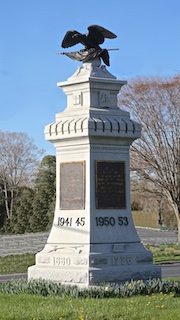
Rose Garden at Bridge Gardens
~~~~~~~~~~~~~~~~~~~~~~~~~~~~~~~~~~~~~~~~~~~~~~~~~~
Bridgehampton, 1656
The first European arrivals settled Bridgehampton and neighboring Sagaponack in 1656, over a decade after the Town of Southampton was settled in 1640 by men and women originally from England by way of Lynn, Massachusetts. The first use of the word Bridgehampton did not appear until 1699, when the bridge at Sagg Pond united the areas then known as Mecox and Sagg.
At the turn of the 20th century, summer resident and renowned American historian James Truslow Adams described these early settlers as folks who possessed courage and perseverance, self-governance, a belief in God, and the human qualities of virtue and vice. The area had its first church in 1686 and a tavern by 1700. Everyone worked, both men and women, and even the minister farmed. These “East Enders,” largely self-sufficient, relied on the land and sea for their livelihoods and sustenance.
For over 200 years Bridgehampton was an agrarian society, its residents content in the rhythms and patterns of an isolated existence. The stagecoach from neighboring Sag Harbor required a three-day journey to reach Brooklyn, barely 100 miles away. But all that changed in 1870, when the arrival of the railroad facilitated the journey of summer visitors from New York City and beyond to the eastern shores of Long Island. By 1877, approximately 36 homes in Bridgehampton were available to summer boarders. Local farmers welcomed the opportunity to increase their income by turning their farmhouses into boardinghouses. Soon after, summer visitors began buying land and building their own houses, developing the neighborhoods closer to the beaches and the heart of the hamlet itself. The increase in summer population, of course, required increased services. More merchants were established, supplying dry goods, hardware, furnishings and groceries. Leisure activities, such as tennis, bicycling, golf, sailing and bathing, all required clubs and clubhouses, which were quickly established. It was not long before these second home owners, often referred to as “summer people,” became an integral part of the area’s economy and fabric of life.
— Excerpt from the introduction to Bridgehampton’s Summer Colony by Julie Green, published by Arcadia Publishing — courtesy of John Eilertsen, Executive Director, The Bridgehampton Museum.
___________________________________________________
Historic Main Street Tour
Bridgehampton – Sag Harbor Turnpike to Butter Lane
Northside ========
Southside ========
___________________________________________________
========================
Abraham Topping Rose House, 1843
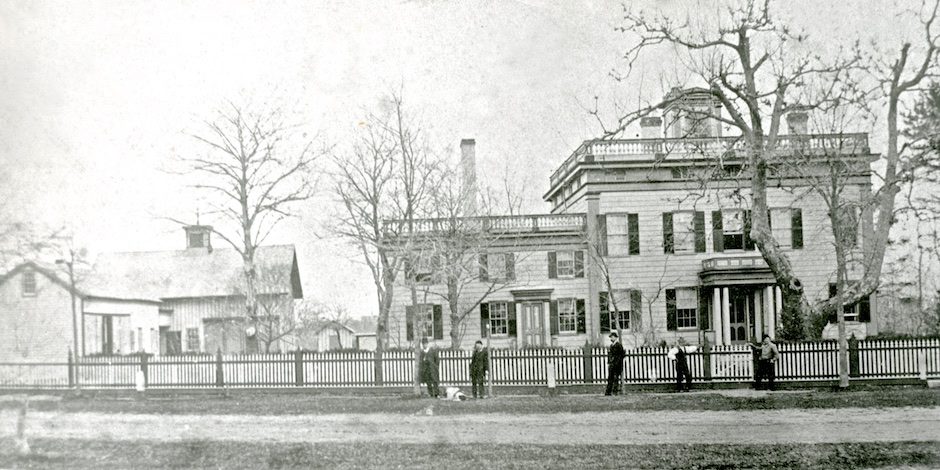
The house of Abraham Topping Rose (1792–1857) was built in 1843 on the existing foundation of an 18th-century home and tavern that he inherited from his father, Dr. Samuel H. Rose (1761–1832), a Revolutionary War surgeon. — Julie B. Greene, Bridgehampton, Images of America / Arcadia Publishing.
AAQ / Resource / Education, Books — Click Here.
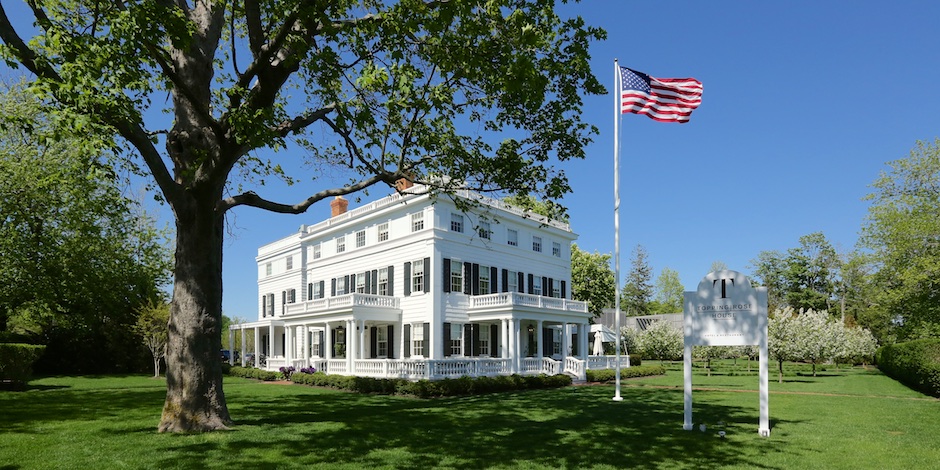
Topping Rose House, 2016
========================
Bridgehampton Monument, 1910
Bridgehampton Monument, located at the intersection of Montauk Highway and Ocean Road, was erected in 1910 in commemoration of the founding of Bridgehampton, the American Revolution, the War of 1812, and the Civil War. The monument consists of a bronze eagle on a granite base which bears four inscribed bronze plaques. — Historic Division, Southampton Town Clerk.
Historic Division, Southampton Town Clerk
~~~~~~~~~~~~~~~~~
“As a memorial to the founding families, who served in the country’s wars, a large monument was unveiled (July 4th weekend, 1910)….Thomas A. Haines, an Army veteran and Albert E. Topping, a Navy veteran of the Civil War, were chosen to slowly raise the flag, revealing the granite memorial….Emil Twyeffort, a summer resident, gave the dedication to a crowd of thousands who surrounded the liberty pole on the historic green.”
— Bridgehampton’s Summer Colony by Julie Greene, Arcadia Publishing.
========================
Nathaniel Rogers House
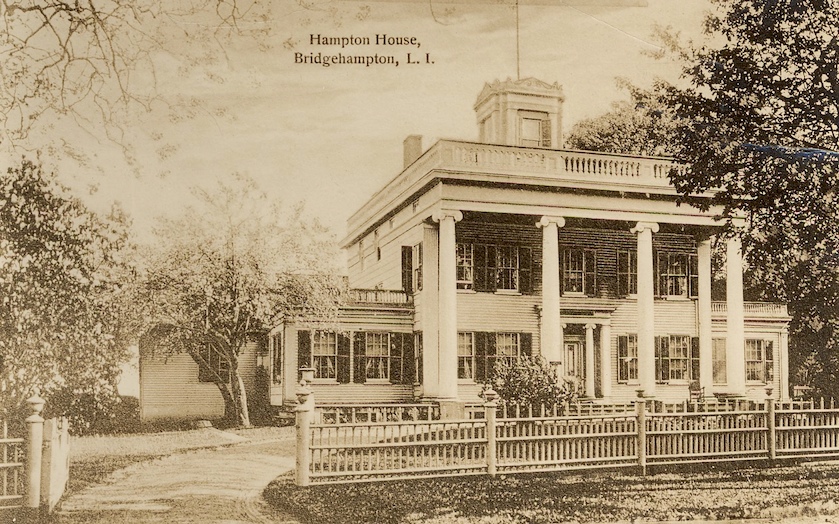
The Nathaniel Rogers House was built by famed painter of miniature portraits Nathaniel Rogers, and included three full stories and a fourth-story cupola, an Ionic two-story front porch with four columns, and elegant rooftop balustrades.
Nathaniel Rogers (1787-1844), one of the founders of the National Academy of Design, was one of the most respected and popular miniaturists of the 19th century and has been described as being the first in rank among American miniature painters. Rogers was born in Bridgehampton, Long Island, to a farmer and the daughter of a local minister. After moving to New York City, Rogers quickly attained prominence and between 1817 and 1831 he exhibited at the American Academy of Fine Arts and the National Academy of Design.
Rogers prospered in his career and in 1839 retired to Bridgehampton and bought and re-modeled an 1820 Federal style house built and owned by Abraham Rose. His home is considered architecturally significant, and according to SPLIA, is one of the two most important surviving Greek Revival structures on Long Island.
The house is listed on the National Register of Historic Places, and has been designated as a Southampton Town Landmark.
— Bridgehampton Historical Society
AAQ / Resource / Education, Books — Click Here.

November 28, 2018
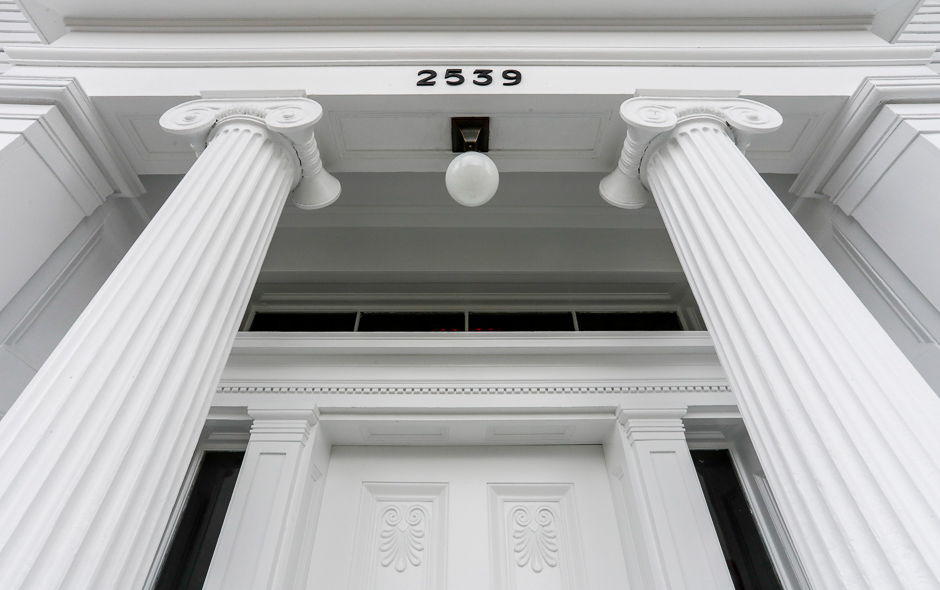
July 31, 2020
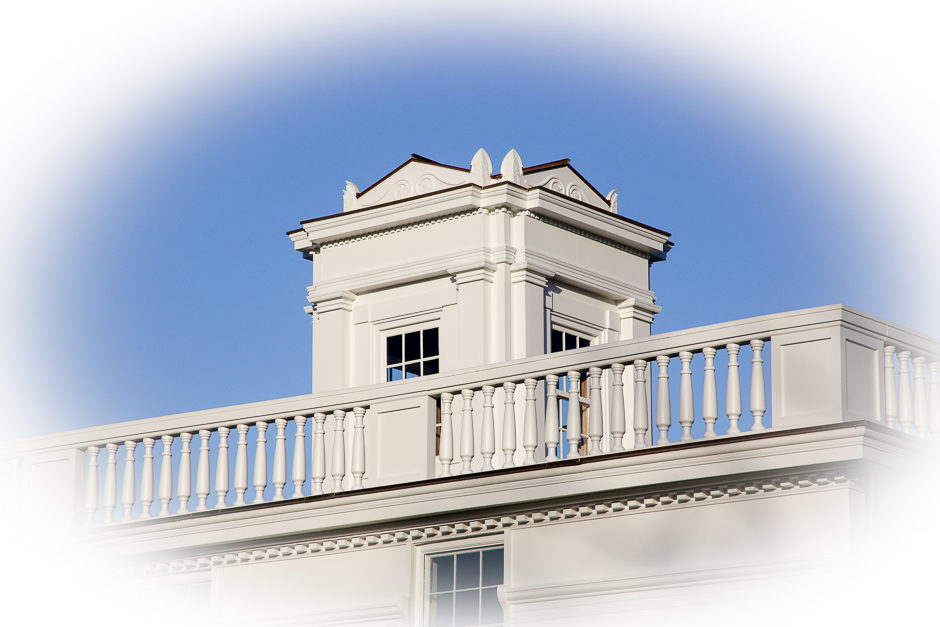
December 3, 2020

May 25, 2021
————
Visit: AAQ / Bulletin — UPDATE / December 3, 2020
Visit: AAQ / Bulletin — UPDATE / July 31, 2020
Visit: AAQ Restoration / The Bridgehampton Museum for additional photos of ongoing restoration work.
========================
Hampton Library
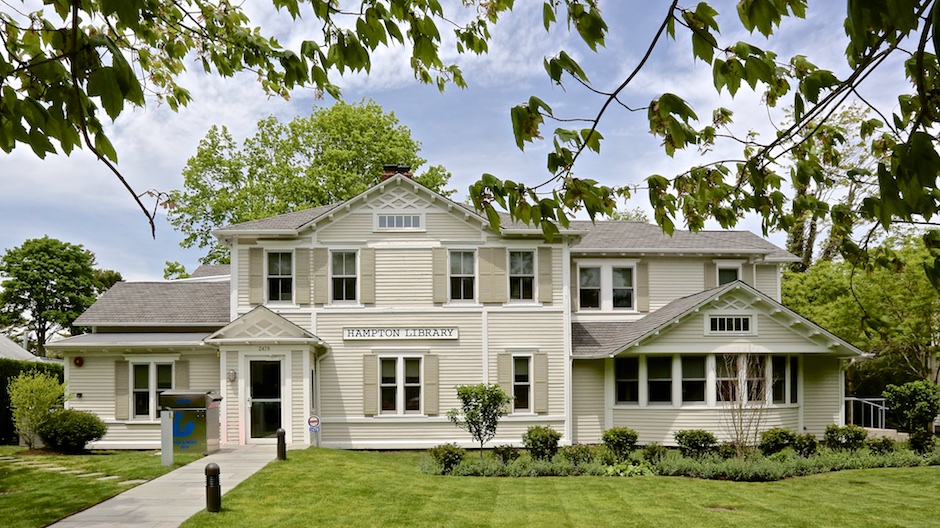
Hampton Library, Bridgehampton. Built 1877, second story 1898. Renovated & expanded in 2009 / Lee Harris Pomeroy Architects.
Founded in 1876, the one-story Hampton Library opened its doors in the spring of 1877. The railroad used the existence of the library as a draw for travelers to make the trip east. To that end, the Long Island Railroad shipped the lumber for its construction gratis. At the time, the library had the largest collection east of Brooklyn. It also had a printed catalog of the entire collection that could be purchased entities. Many boardinghouses bought the catalog for summer guests to peruse. Cottagers and boarders could join the library for one year for $1, or they could buy a part-year subscription: three months for 75 cents or two months for 50 cents. In 1898, the library raised its roof and added a second story, for the librarian’s housing. — Julie Greene, Bridgehampton’s Summer Colony, Images of America / Arcadia Publishing.
AAQ Resource / Education / Books — Click Here.

========================
St. Anne’s Episcopal Church, 1907

St. Anne’s Episcopal Church, 1907
Saint Ann’s Episcopal Church was constructed in 1907. The stucco-clad structure exhibits elements of the Mission and Spanish Colonial Revival styles. It has a hipped roof, a front-gable entry hyphen with a Moorish pointed arch, and an off-center steeple. — Town of Southampton.
——————–
St. Ann’s Episcopal Church, once the Sagaponack Golf Clubhouse, was moved to Main Street. In 1915, the chapel was redesigned by the architect James Ware of New York City. Ware had earned early praise and recognition for pioneering modern fireproofing, improving city dwellings for the poor, and designing the Mohonk Mountain House in New Paltz, New York. — Julie Greene, Bridgehampton’s Summer Colony, Images of America / Arcadia Publishing.
AAQ / Resource / Education, Book — Click Here.
~~~~~~~~~~~~~~~~~~~~~~~~~~~~~~~~~~~~~~~~~~~
Bridgehampton Presbyterian Church, 1842

Bridgehampton Presbyterian Church, 1842
The Bridgehampton Presbyterian Church was most likely designed by Nathaniel Rogers, in the Greek Revival style. The clapboard-clad building features Ionic pilasters, pointed-arch windows, and the original spire. A port-cochere on the east side, a porch on the north side, and a clock were late 19th century additions. — Historic Division, Southampton Town Clerk.
========================
Bridgehampton Hook & Ladder Company, ca. 1908
— just north of Main Street —

Bridgehampton Hook & Ladder Company, ca. 1908. Now the Dan Flavin Art Institute.
This three-story shingle-clad turreted building served as the Bridgehampton Hook & Ladder Co. fire department from 1908-1923. In 1924, under the leadership of H.D. Strotter, it was purchased by the newly organized First Baptist Church of Bridgehampton, and used as a chapel. It is currently occupied by the Dan Flavin Art Institute. — Town of Southampton.
========================
Bridgehampton Candy Kitchen, 1925

Operated as the Candy Kitchen since it was constructed in 1925, this luncheonette and soda fountain is a two-story brick commercial building with a triangular plan and a chamfered entry bay. The original signage remains in place. — Town of Southampton.
========================
Bridgehampton Community House, ca. 1923

Bridgehampton Community House
The Bridgehampton Community House, a large, Classical Revival-style community house with two-story height entry portico, was constructed circa 1923. Construction of the Community House was instigated largely by local resident and author James Truslow Adams, and was constructed through the donations of local residents. The venue was used for movies, plays, dances, and other community events. — Town of Southampton.
========================
William Corwith House, ca. 1840
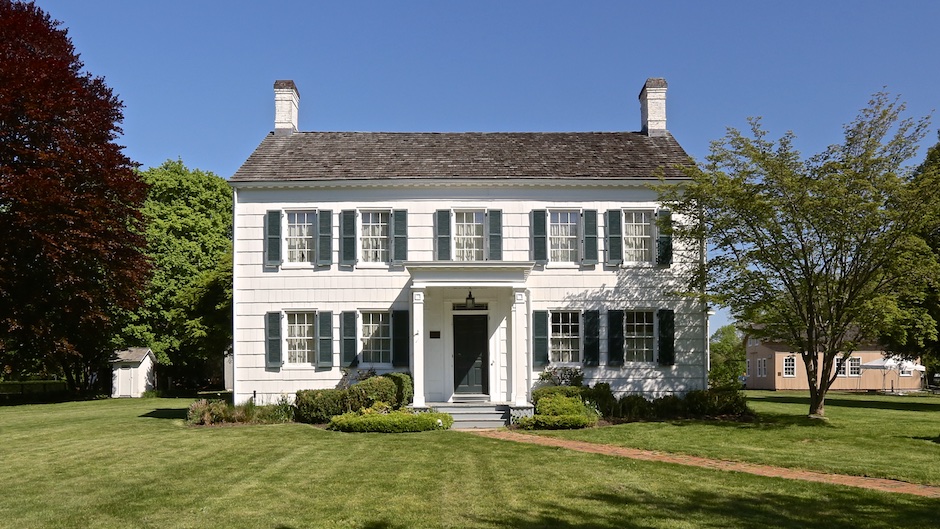
William Corwith House / Bridgehampton Historical Society
It is a vernacular five-bay Greek Revival-style house built by William Corwith ca. 1840; the house has two brick end chimneys, six-over-six-light wood window sash, and is clad in wood shingles. The house remained in the Corwith family until 1960, and soon after became home to the Bridgehampton Historical Society, which it remains today. Also on the property are the former Bridgehampton Jail, the Strong Blacksmith and Wheelwright Shop, and multiple barns and outbuildings that were moved to the site in the late 20th century. — Town of Southampton.
In 1877 a brochure was compiled and distributed by the Long Island Rail Road called “Long Island and Where to Go”. The brochure contained information about the train schedules, rates, destinations, sports, church denominations as well as hotels and boarding houses within 5 miles of the depot in each town on the island.
The pages on Bridgehampton include the number of trains a day (2), the rates (single fare, $2.40, excursion, $4.35), comments on the beach and pond, the Library, founded just the year before, in 1876, and a list of 35 places to board.
Since there were no hotels in Bridgehampton residents opened their houses to summer boarders. The list for Bridgehampton included the house of William A. Corwith and notes he could accommodate 15 boarders. Mr. and Mrs. Corwith had three daughters and there were probably 2-3 live in servants. Therefore, there were 22-23 people sleeping and eating in the Corwith House in the summer!
In the early 1880s, Mr. Corwith saw he could augment his income even more by taking in more summer boarders, so he enlarged his house. (Many other families did the same thing at this time. James A. Rogers is listed as taking in 30 boarders!). Mr. Corwith added a large dining room and several bedrooms on the second floor. The boarders rented the larger family bedrooms, and the family moved to the new small bedrooms in the back. Boarders and family had to double up, 3 or 4 or more to a room. — Bridgehampton Historical Museum.
www.bridgehamptonhistoricalsociety.org
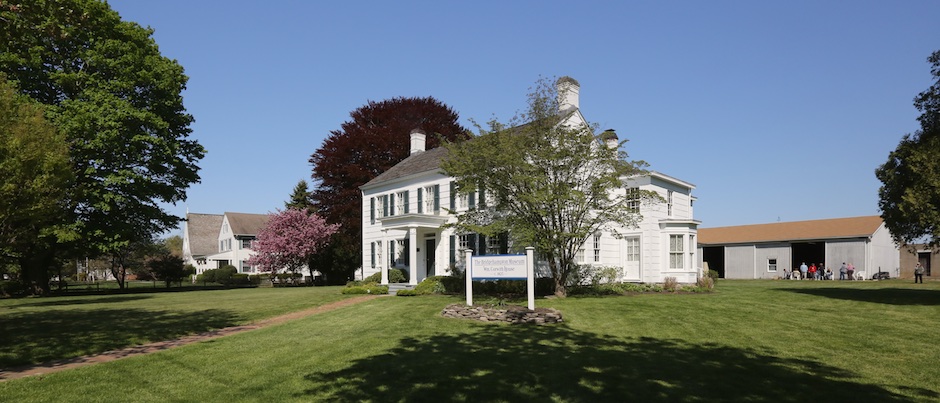
The Bridgehampton Historical Museum
~~~~~~~~~~~~~~~~~~~~~~~~~~~
Strong Wheelwright Shop, ca 1870s
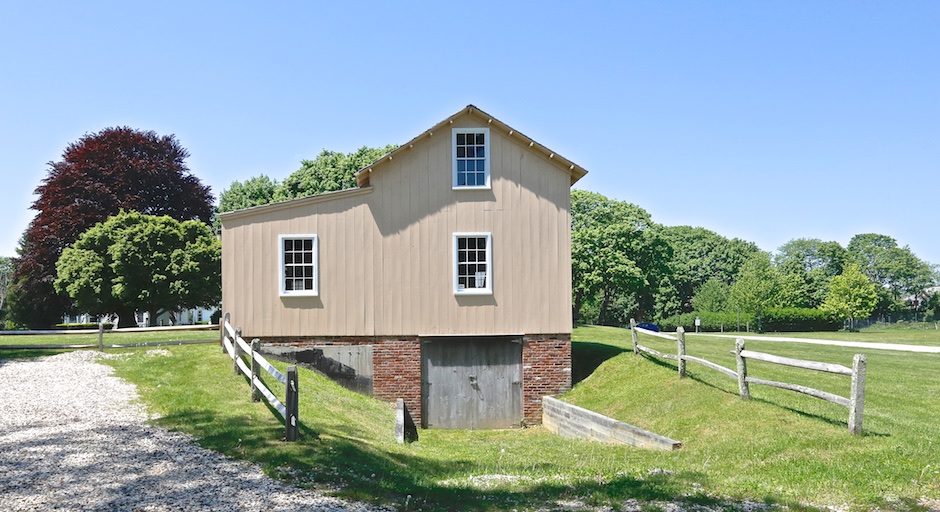
The Strong Wheelwright Shop at the Bridgehampton Historical Museum was donated by the Strong family in 1962.
The Strong Wheelwright Shop was built in the 1870s. It was used until 1927 by George W. Strong in his wheelwright business while at its original location on the Strong Farm in Wainscott.
========================
Bridgehampton United Methodist Church, 1833
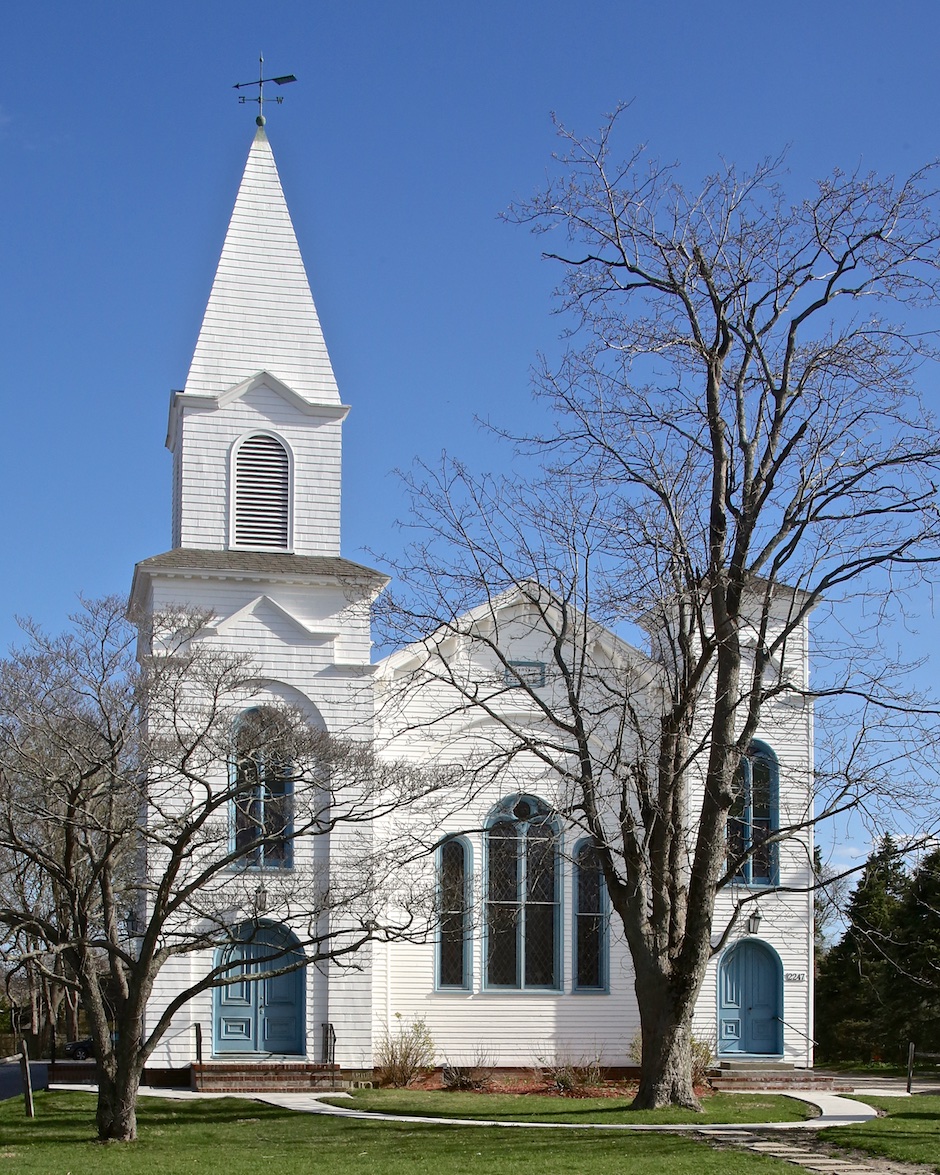
Bridgehampton United Methodist Church
The Bridgehampton United Methodist Church was constructed in 1833 on another lot on Montauk Highway. Due to an expanding congregation, the church was moved to its current site and substantially expanded in 1871. The upper portion of the steeple was rebuilt, probably in the early 20th century. — Historic Division, Southampton Town Clerk.
Historic Division, Southampton Town Clerk
=======================================
Bridgehampton Excursions South of Main Street
~~~~~~~~~~~~~~~~~~~~~
Beebee Windmill, 1820, Ocean Road

Beebee Windmill, 1820, Sag Harbor, relocated to Bridgehampton, 1915.
The Beebee windmill was built on Sleight’s Hill, Sag Harbor, in 1820 for Lester Beebee, a retired whaling captain and shipbuilder. The construction was undertaken by Pardon Tabor, a local woodworker and fine craftsman, and Samuel Schellinger, an Amagansett millwright. At the time of completion, the Beebee Windmill was the tallest structure in Sag Harbor. It was the miller’s custom to hoist a flag from the top of the curved ogee cap whenever a homeward bound whaling vessel was sighted in the Bay. The local expression to describe the event was “Flag on the mill, ship in the Bay.”
Following Lester Beebee’s death, his brother sold the mill to Judge Abraham Topping Rose, a descendent of one of Bridgehampton’s original settlers, and Richard Gelston, owner of The Bull’s Head Tavern. Rose and Gelston had the massive mill hauled down the turnpike to Bridgehampton and placed on a high piece of ground just north of the present Presbyterian manse. For the next half century it operated there under a succession of different owners, including Charles Norris, Major Roger Francis, Squires Hedges Miller, Charles Topping, E. Jones Ludlow, Albert Topping and Lafayette Seabury.
In 1882, the mill was purchased by James A. Sandford who moved it for the second time in 1888 to a site near the railroad station. To lessen the mill’s dependence on the vagaries of wind, Sandford subsequently installed a steam engine in the mill. In the same year, Nathanial Dominy VII, scion of a long line of windmill builders and clockmakers, made extensive repairs to the mill. In 1899, the mill was purchased by Oliver Osborne and moved to the north side of the railroad tracks. In 1900, the mill was sold to the Bridgehampton Milling Company, which operated it for many years.
In 1915, John E. Berwind, an affluent Bridgehampton summer resident, bought the mill and moved it to the grassy green next to Minden, his summer estate. Berwind, a Pennsylvania industrialist and an enthusiastic supporter of local causes, was instrumental in establishing the Community House, located in the center of the Village of Bridgehampton. It was fitting, therefore, for his widow to will the Beebee Windmill and two acres of land on which it stands to the Town of Southampton as a memorial to her late husband. — Bridgehampton Historical Museum.
www.bridgehamptonhistoricalsociety.org
========================
John and Katherine Berwind’s Minden, 1913
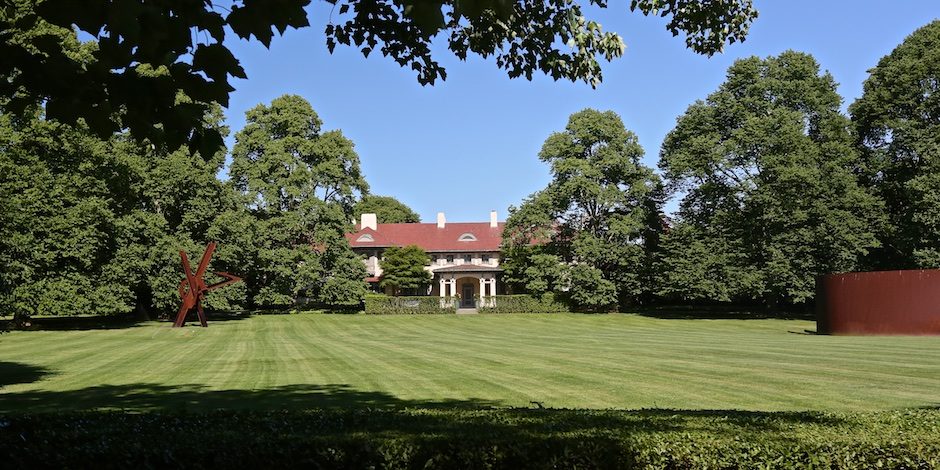
The Berwind Estate, originally called Minden, is a large Italian villa-style mansion with complex low-pitched hipped roofs with overhanging eaves. The stucco-clad structure has segmental-arch windows and arcaded hip-roofed porches. It is situated on a rise within extensive grounds. The property was developed in 1913 as a summer estate for John and Katherine Berwind. It has since been used as a retreat, a spa, and a private residence. — Town of Southampton.
—————-
John E. Berwind was one of four brothers who established one of the largest bituminous coal companies in the world, Berwind-White Coal Co., supplier to the US Navy and the Cunard Line. Born of Prussian immigrants in Philadelphia, the Berwind brothers had, by the 1880s, amassed a fortune comparable to the Morgans, Vanderbilts, and Astors. — Julie Green: Bridgehampton’s Summer Colony / Images of America Series / Arcadia Publishing.
AAQ / Resource / Education, Book — Click Here.
========================
Bridgehampton Excursions North of Main Street
~~~~~~~~~~~~~~~~~~~~~
Children’s Museum of the East End (CMEE)

Children’s Museum of the East End (CMEE), 2005. Lee Skolnick Architecture + Design Partnership.
The Children’s Museum of the East End upholds its mission “to spark imagination and foster learning for children of all backgrounds and abilities and to build strong connections within the East End community by providing playful experiences” by presenting educational exhibits and programs and by partnering with other arts and social service organizations to address issues that concern families in the community. –— Children’s Museum of the East End.
========================
South Fork Natural History Museum (SoFo), 2005
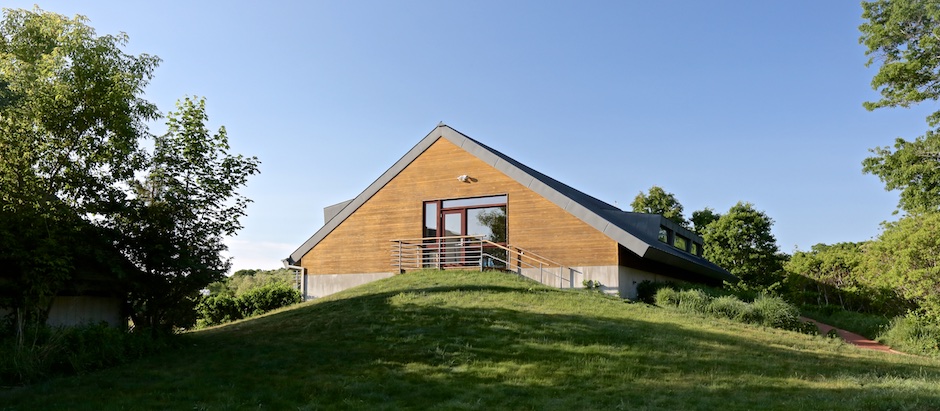
South Fork Natural History Museum (SoFo), 2005. Rogers Marvel Architects. Quennell Rothschild & Partners, Landscape Architects.
The mission of the South Fork Natural History Museum & Nature Center – SoFo is to stimulate interest in, advance knowledge of, and foster appreciation for the natural environment, with special emphasis on the unique natural history of Long Island’s South Fork. — South Fork Natural History Museum & Nature Center.

Long Pond Greenbelt — accessible from Sofo site.
www.longpondgreenbelt.org
========================
Peconic Land Trust’s Bridge Gardens
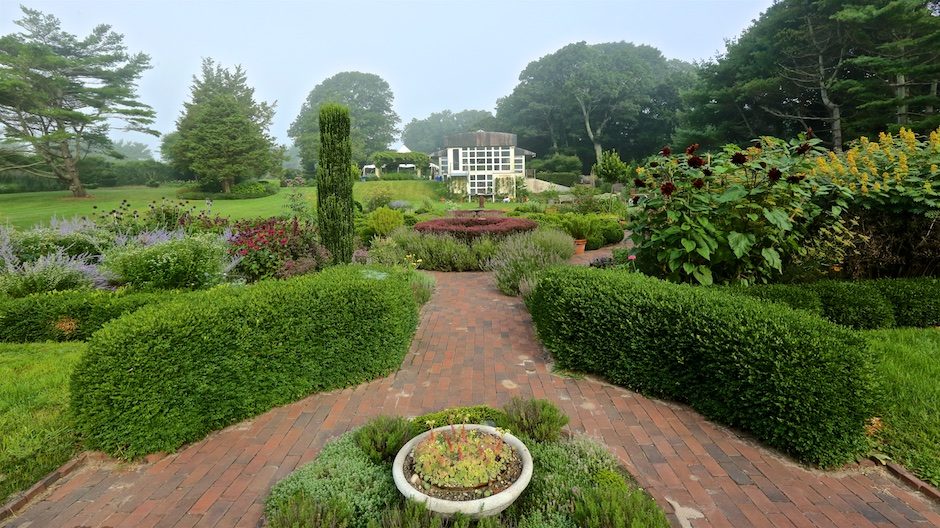
A unique public garden in the heart of Bridgehampton, Bridge Gardens was donated to the Peconic Land Trust in the fall of 2008 by founders and horticulturalists Jim Kilpatric and Harry Neyens. Kilpatric and Neyens began designing and installing the gardens in 1988, and over the ensuing 20 years created a wonderful oasis that spans over five acres and includes many specimens of trees, shrubs, hedgerow, roses, perennials and herbs. — Courtesy of the Peconic Land Trust.
Visit: AAQ / Portfolio / Art: PLT: Bridge Gardens / Selections, April – November
========================
Bridgehampton Archival
~~~~~~~~~~~~~~~~~~~~
Sagg Bridge,1686
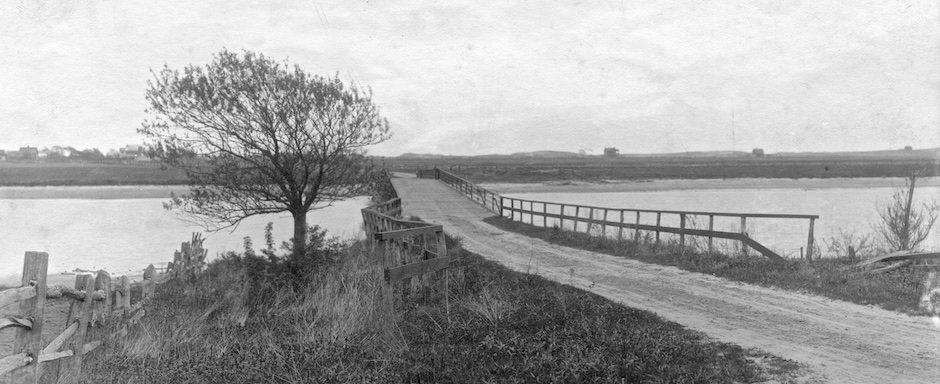 Archival postcard courtesy of the Bridgehampton Historical Museum.
Archival postcard courtesy of the Bridgehampton Historical Museum.
========================
Bridgehampton – Sag Harbor Turnpike
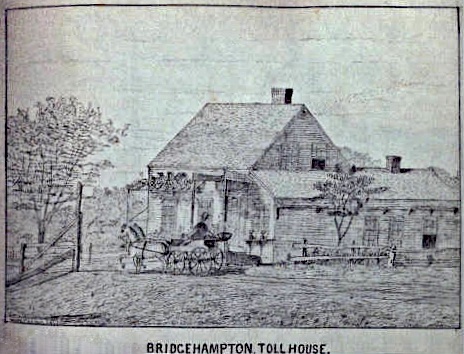
========================
Ludlow Grange, 1880

Ludlow Grange, 1880, Bridgehampton. Archival photograph courtesy of the Bridgehampton Historical Museum.
This house was built by Captain Isaac Ludlow (1807–1871), who first went to sea at the age of fifteen and made twenty voyages on whaling ships (eight of them as commander of his vessel) before he retired in about 1857. Rewarded with a fortune that enabled him to build this imposing residence, he also earned the gratitude of the British Admiralty for having rescued 105 of the passengers and crew of a British bark that was wrecked in the Indian Ocean in 1835. — Mary Cummings: Southampton, Images of America / Arcadia Publishing.
AAQ / Resource / Education, Books — Click Here.
========================
Tremedden, 1882
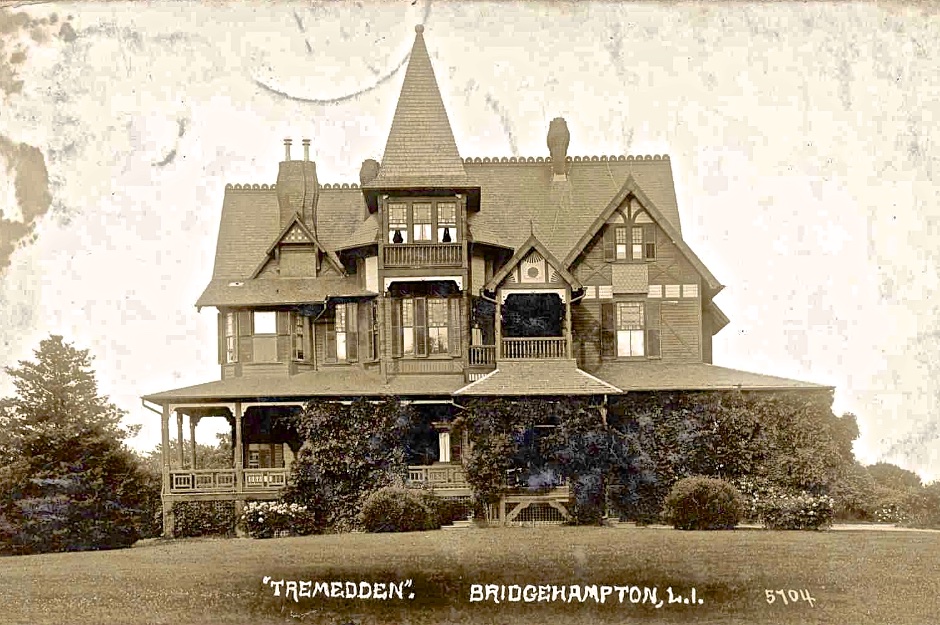
Tremedden, 1882, Bridgehampton
The era of the elaborate summer “cottage” began early in Bridgehampton, where fountain pen magnate Richard Easterbrook built “Tremedden” on the corner of Sagaponack Road and Ocean Road over a five-year period from 1877 to 1882. In 1916 Charles Evans Hughes, who was running for president at that time, went to bed in this house on election night believing he had been elected only to find the next morning that late returns from California gave the vote to Woodrow Wilson. “Tremedden,” which is Welsh for “trees in the meadow,” was torn down during the Great Depression when money for the upkeep of such a lavish estate was hard to come by. — Mary Cummings, Southampton, Images of America / Arcadia Publishing.
AAQ / Resource / Education, Books — Click Here.
========================
Bridgehampton Race Circuit, 1957 / 1971
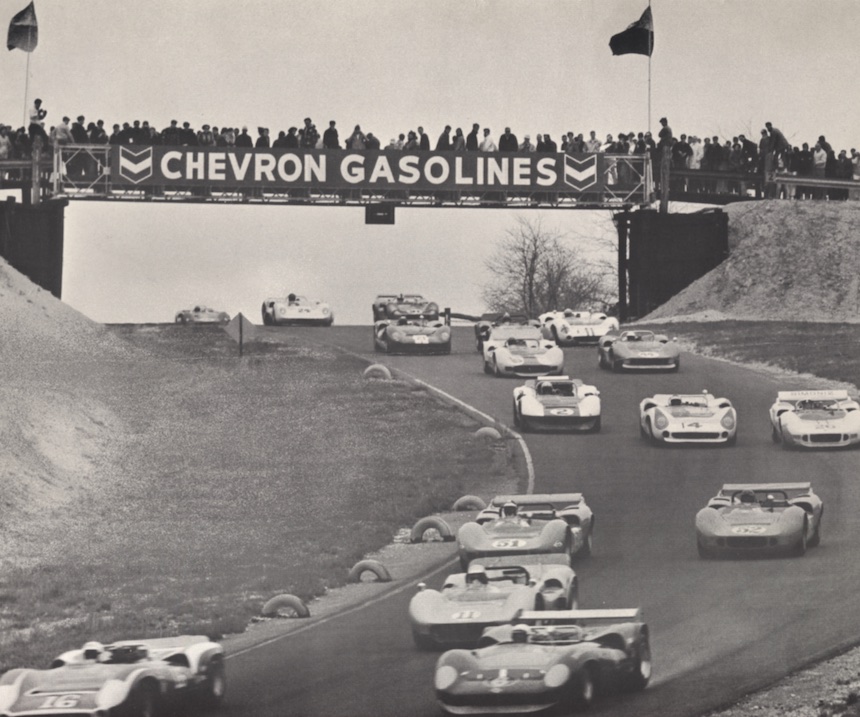
================================================
For further information on Bridgehampton, please visit:
www.bridgehamptonhistoricalsociety.org
And, these AAQ links:
AAQ Landmarks — Beebee Windmill, 1820, Bridgehampton
AAQ Restoration — Nathaniel Rogers House
Also, this link:
AAQ / Resource / Education / Books for Local History Books

Atlantic Ocean, June 16, 2006
———————————–
Photographs, except archival, copyright Jeff Heatley.

